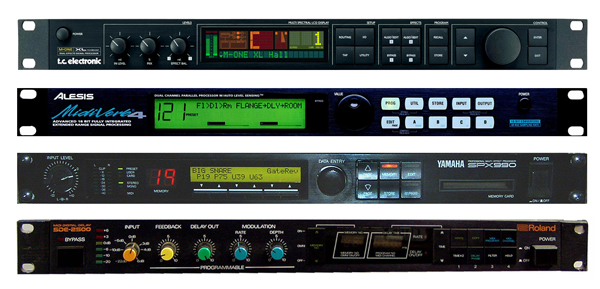
For example, let’s say there’s an echo that needs to happen in the middle of a particular song. I set it up and have it ready, then when the right time comes, slide up the appropriate fader and then back down, and it’s on to the next effect.
Four effects units reside in my own club rack – one for delay on vocals, one for reverb on vocals, one for reverb on drums, and one that I use to achieve certain other things.
This unit is programmed ahead of time with different delay times, echoes, flanges and so on that I want for that night’s show.
Again at risk of stepping into the land of the obvious, I always name these effects according to the song they’re to be applied to. This way I don’t have to try to try to remember different setting names in the heat of the mix.
The extra unit also means I can leave my main reverb and delay settings untouched while adding the extra effects where and when I want them.
Many of the more common and affordable effects units now on the market come with the ability to pre-program several different effects on one channel, eliminating the need to purchase several units.

Keep in mind, though, that this can present some limitations.
To bring up the volume of the reverb, but not the delay, requires doing so in the effects unit settings rather than just pushing up a console fader.
And there is access to only the effect “sounds” and features/options provided by the given manufacturer of the unit. Still, the majority of units offer plenty of effects options.
One key difference is sound, which is where you come in, because as we all know, sound “quality” is a subjective evaluation.
Experiment by listening to various units to find the one (or ones) best for your operational needs and sonic situation.
If possible, rent a unit for a week or two to check out before buying, and never be afraid to ask the advice of others.
Tim Andras is a mix engineer with well over two decades of experience working with sound.
